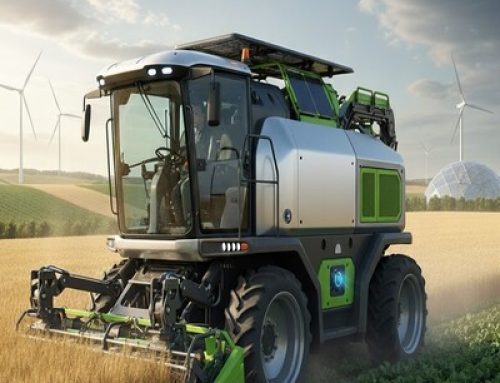Source: Performance Livestock Analytics
| To view all photos, Click Here. |
Osage, Iowa -The cattle industry has seen a sharp rise in technology in recent years. While new high-tech tools are promising, they also have to be practical, user-friendly and offer a solid return on investment before cattle producers invest.
The surge of new technology brings both optimism and skepticism. We talked to cattle producers and related experts about seven tools they’re excited or concerned about, think have value or are considering for their operations.
Electronic identification (EID) tags
Individual animal identification is top-of-mind for many producers.
Missouri rancher Matt Poindexter hopes for complete birth to butcher traceability. “We should be able to keep records from the day a calf is born to the day it’s hanging on the rail and have the information move back and forth across the supply chain,” he says.
If cow/calf producers used more EID technology and passed data to backgrounders, finishers and packing plants, it would improve management practices, protocols and production strategies, Poindexter says.
“I’d know what shots were given and when, solving comingling issues by pairing groups with the same vaccines,” he says. “I could even isolate bloodlines more susceptible to sickness to improve my herd.”
South Dakota rancher Chris Howard’s interest in individual identification lies in pasture management. He would use the added data to confirm correlations between movements and rotational grazing timing.
“My theory is at a certain threshold, cows move more to attain the same level of forage intake. If I identify this threshold, my rotational grazing will be more efficient,” he says.
On a simpler note, he’d also welcome ‘The cows are out!’ alerts.
For producers considering or already using EID tags, here are a few ideas to make sure you’re getting the most out of your tag investment.
Performance tracking through the chain
Many producers show interest in pairing performance tracking software with EID tag systems for better decision-making.
Iowa-based Ryan Brothers Inc. buys 700- to 800-pound calves and feeds them to finish.
“If I could share EID information with a cow/calf guy and continue the data to finishing and slaughter before it returns to them, it would be huge,” says co-owner Pat Ryan. “If there is enough good information on the tags to track performance, we’d know next year when they’re selling those calves again if they were a good or poor buy.”
He thinks this historical information, including accurate finishing weights, would guide purchasing and sorting strategies.
Nebraska rancher Paul Johnson agrees that receiving data back on the steers, replacements and bred heifers he sells each year would be beneficial.
“We don’t get any data back as we don’t have the facilities to finish our cattle,” Johnson says. “It would be nice to know how they do. We see what they gained but that’s it. With more information, we’d put extra value on carcass merit for our herd.”
Herd management software
Many cattle feeders have long relied on handwritten notes to manage feeding, inventory, health, marketing and more. Pen and paper have obvious limitations, including human error and physical degradation.
North Carolina feeder Brandon Pardue wanted to stop passing scraps of paper to the loader operator mixing ingredients, who then transferred them to the feed truck driver.
Pardue picked Performance Beef from Performance Livestock Analytics to help him manage details that could otherwise get lost. “I love the simplicity and handiness of it,” he says. “When tallying up a group, we aren’t worried about every number and date we wrote down. What went into the group is right in front of us.”
He loves how the software removes inventory automatically and puts it directly where it’s supposed to go. “You know a group’s cost every day,” he says. “Having the accuracy of feeding, weights and inventory numbers has saved us time, improved efficiency and added profit. Plus, the detailed analytics and reports assure our clients.
Feed bunk management
Reading and responding to feed bunk conditions is often considered an optional task. If done at all, it typically falls to a feedlot employee scribbling down a few notes while traveling past the bunks. This “unofficial” task can make or break profitability as bunk mismanagement leads to extra days on feed, bloats, average daily gain valleys and feed conversion pitfalls.
“I wanted to view remotely when bunks were going clean as I’m often away,” says Lance Hamman, Iowa feedlot owner and new Precision Livestock Technologies user. “I needed 24-hour monitoring to eliminate the wild swings in feeding and stay ahead of the trend curve for what my pens were doing.”
Precision Livestock Technologies’ machine vision system tracks bunks and feeding behavior via 24/7 camera monitoring. Hamman believes this tool has increased average daily gains and improved feed efficiency.
“It provides enough information even the novice can use to make more accurate decisions, but there’s plenty to keep the experts busy.”
Feed efficiency
“Feed efficiency is our next low-hanging fruit,” says Wisconsin beef producer Jared Geiser. “Days on feed and actual feed costs are the two biggest drivers of profitability. Getting a jump on selecting the most efficient animals for our environment sets us up for success.”
He appreciates that some companies measure feed intake through smart bunks weighing feed consumption. Startup costs can be high, though, which prevents most average producers from accessing this tool.
“Feed efficiency is the next logical step for selecting highly functional and profitable cattle,” Geiser says. “The industry is behind the rest of the world in traceability and advanced reproduction. We must step up and use advancing technologies when they become more available, practical and affordable.”
Genetic testing and selection
Genetic testing isn’t a new idea, however more commercial cow/calf operators now want testing data for bulls they purchase.
Troy Rowan, assistant professor and beef genetics extension specialist at the University of Tennessee Institute of Agriculture, says widespread use of genetic tests is the largest technological leap of the last two decades.
“Historically, commercial buyers made purchases with limited information and minimal data,” he says. “Genomics and genetic testing have instilled more confidence as large amounts of accurate data become available. Integrating genomic evaluations to help reduce the risk associated with these large investments creates a major advancement.”
Shared concerns
Technological advances are exciting, but government interference and regulation worry many.
Poindexter is hesitant about mandated animal identification. “I know there is demand for it, and when voluntary, then fine. If enforced, then no. It needs to be our option.”
Ryan agrees. “It’s a changing industry. We’re fighting rules and regulations we don’t necessarily like.”
Johnson adds, “The line we must walk is that it would be nice to do all these things but I’m not a fan of government overreach. For my sake, I’d love GPS trackers on every cow, but the possible consequences scare me.”
Geiser is concerned about secondary selection pressure and missing the big picture when focusing too much on feed efficiency. “Does relying on this technology cause an antagonistic relationship with marbling, milk, foot health, docility and more? Do we spend too much money and effort chasing technologies and miss opportunities to contract/hedge profitably in search of the next dollar down the road?”
Cost and ROI play major roles in how a technology is perceived.
“Either we adapt or die as an operation. It’s how it goes,” Johnson says. “If something specific becomes cost-effective, we need to take a long, hard look at it and not just automatically rule things out.”
Howard says, “Dollars are the potential drawback with anything. If it’s something I’m interested in, I’d try it if it’s financially feasible.”
To the future and beyond
Cattle producers are interested in technologies that improve efficiency, reduce labor and provide useful data. Many are opening their minds and occasionally their pocketbooks for the right opportunities.
The future will reveal which technologies get adopted and stick around for the long haul.
Performance Livestock Analytics is a technology company that simplifies data and analytics for the livestock industry. Our team used practical insights from producers and data engineers to create the industry’s first cloud-based platform. We provide livestock producers with powerful analytics to make better marketing and management decisions, improve sustainability and boost profitability.



